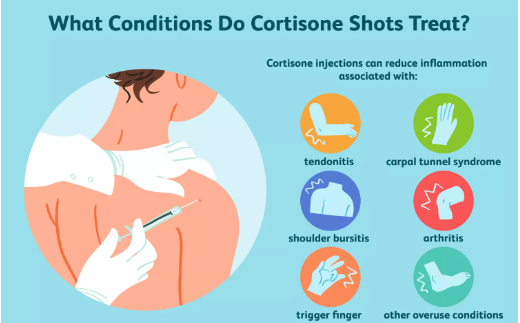By Jonathan Cluett, MD
Medically reviewed by Laura Campedelli, DPT
Most healthcare providers recommend getting a cortisone shot no more than three times a year in a single joint, and no more than six times a year in total. They typically also recommend spacing out each injection by at least 12 weeks.
Getting too many cortisone shots can cause serious problems like damaged cartilage and bone death. It can also make it harder to manage other conditions such as diabetes.
This article explains how cortisone shots work and their overall effectiveness in reducing joint pain and inflammation. It also outlines the maximum number of shots a person should receive per year and the risks of overuse.

How Cortisone Injections Work
The goal of a cortisone injection is to improve pain and inflammation. Cortisone does not treat the underlying condition; it only treats the symptoms.
Cortisone injections are used to treat many joint problems, including:
Bursitis
Tendonitis
Trigger finger
Carpal tunnel syndrome
Tennis elbow
Knee arthritis
Many types of overuse injuries
Cortisone is a type of steroid hormone that works by decreasing inflammation.1 Inflammation is the body's normal response to an injury, infection, or disease as a means to heal itself. However, when a condition is persistent and the inflammation is chronic, the symptoms of inflammation—including pain and swelling—can become intolerable.
By decreasing inflammation in a joint space with cortisone, pain and swelling can be reduced and joint mobility can be improved. Shots given into a joint space are referred to as intra-articular injections.
Effectiveness
Cortisone shots are effective for treating pain; they provide immediate relief that can last for months. This doesn't mean, however, that the underlying condition has also improved.
With knee osteoarthritis, for example, the damage to the joint is ongoing and doesn't stop simply because you feel no pain. In fact, because you feel good, you may place undue stress on the joint and add to the existing damage.
For pain and inflammation from an injury, a cortisone injection may help you feel more comfortable while your body heals, but the effects are temporary. This is why they are better suited for treating injury rather than long-term conditions.
For example, studies have found that corticosteroid injections given to treat tennis elbow are effective for up to six weeks, but that symptoms will often recur within a year. Additionally, many people report side effects like pain and skin atrophy following a cortisone injection.2
Cortisone injections can provide rapid, effective relief of joint pain and stiffness, but they are not considered a long-term solution.
Cortisone shots do not help every orthopedic problem. Those with acute inflammation (meaning inflammation that is rapidly developing and recent) tend to respond well to intra-articular cortisone. Those with chronic inflammation (inflammation that is persistent and long-lasting) may find better, more lasting relief with physical therapy and other treatments.
Side Effects
Cortisone shots can have serious side effects, and the risk of side effects increases when you get cortisone injections regularly. Some of these side effects include:
Damage to cartilage
Bone weakness or bone necrosis (death)
Nerve damage
Joint infection
Weakening of the skin and soft tissue
Weakening of tendons
Immune system problems
Because of its hormone-like effects, cortisone can also make conditions like diabetes more difficult to manage.
How Many Cortisone Shots Can You Have?
There is no hard-and-fast rule about the number of cortisone shots a person can receive in a lifetime. But generally speaking, healthcare providers do not like giving repeated cortisone shots to the same joint — such as the knee or the back — again and again.
To avoid serious side effects, orthopedic surgeons will generally limit the number of cortisone shots you can have in a year to no more than three in any one space and no more than six in total. Additionally, healthcare providers usually recommend spacing the shots out by at least 12 weeks.
There are exceptions to the rule. For example, if someone with severe knee arthritis is advised to delay knee replacement surgery, additional shots may be reasonable. This is because knee replacements are typically delayed for as long as possible to ensure they last for the duration of the person's life.
On the other hand, if multiple shots are needed because the pain relief is inadequate, giving additional shots will not likely be of any real benefit. If anything, the shots may cause more harm (in terms of damage to cartilage and bone) than good. Other treatments may be far more effective.
Because of these and other concerns, you should listen to your healthcare provider if they suggest there are better options for you than cortisone. The treatments may not provide immediate relief, but they can possibly preserve the function of your joint more effectively.
Summary
Cortisone shots are commonly used by orthopedic surgeons and other healthcare providers to reduce pain, stiffness, and swelling in a joint. The drugs work by quickly reducing the inflammation that causes pain.
As effective as cortisone shots can be, their effects are usually not permanent. Because the overuse of cortisone can damage cartilage and bone, orthopedic surgeons try to give no more than three shots per year to any body part. Exceptions can be made on a case-by-case basis if there is a serious condition in which the benefits outweigh the risks.
Sources
Daftary AR, Karnik AS. Perspectives in ultrasound-guided musculoskeletal interventions. Indian J Radiol Imaging. 2015;25(3):246-260. doi:10.4103/0971-3026.161445
Hsieh LF, Kuo YC, Lee CC, Liu YF, Liu YC, Huang V. Comparison between corticosteroid and lidocaine injection in the treatment of tennis elbow: A randomized, double-blinded, controlled trial. Am J Phys Med Rehabil. 2018;97(2):83-89. doi:10.1097/PHM.0000000000000814
By Jonathan Cluett, MD
Jonathan Cluett, MD, is board-certified in orthopedic surgery. He served as assistant team physician to Chivas USA (Major League Soccer) and the United States men's and women's national soccer teams.





Post comments